A tangle of red, white, and black wires occupies a series of lab rooms on the second floor of Williams Hall, next to the iconic Burruss Hall on the Virginia Tech campus.
“Those wires take the biological signals from the body and convert them to the digital signals that we can see on this graph,” explains Alisa Huskey, a 5th year PhD student and senior graduate member of the Mind-Body Lab. The wires are called transducers and they have clips on the ends of them that look somewhat like clothespins. Huskey is busy clipping the transducers to little adhesive patches that she has stuck on the skin of her latest research participant. These patches “listen” for the electrical signals coming from the body and transmit the signals to the transducers. After she connects the participant, Huskey moves to the room next door and closes the blinds, obscuring the view of Burress Hall just out the window.
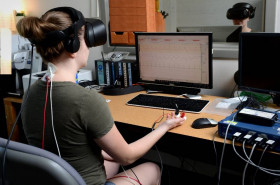
“The one-way mirrors require that we work in darkness, so we can see the participant, but not the other way around,” Huskey explains. Other than the wires and the one-way mirror, the Mind-Body Lab mostly looks like a regular office, complete with a bookshelf, desktop computers, and filing cabinets.
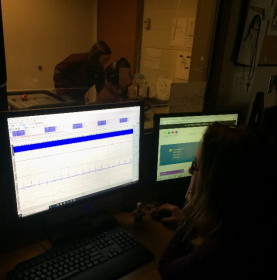
“This is not a ‘wet lab’,” pitches in Alex Faunce, a 2nd year PhD student and member of the lab, “so you won’t see the stereotypical beakers and liquids in this lab.” The lab also does not work with animals nor does it work invasively, Faunce explains. All those patches on the participant, called electrodes, are for listening only - the lab uses strictly non-invasive measures.
Founded over twenty years ago by Dr. Bruce Friedman, the Mind-Body Lab studies how to better understand the mind and the psyche by measuring the body and its energy. These physiological measurements are made by “listening” for the electrical signals the body gives off.
“One of the main measures we use is electrocardiography, or ECG”, explains Dr. Friedman. ECG is the measure of the electrical signals from the heart displayed as a graph. “The heart gives off the strongest electrical signal in the body, so it’s easy to measure and there’s a lot we can learn from heart rhythm,” Friedman explains. All 4 of the current graduate members of the lab use ECG for their research, in spite of the widely differing research questions each member is investigating.

“We do all use the ECG equipment,” explains Brittany Nackley, a 3rd year PhD student/graduate member of the lab, “but each of us has also gotten pretty creative using additional equipment we need for our projects.” For example, Huskey retrofitted an industrial-sized air compressor to deliver a blast of air to each participant’s neck. This irritating stimulus was more acceptable than an electric shock to the Institutional Review Board (IRB) who determines the ethical merits of each project. Huskey uses the air blast to simulate a threat, allowing her to measure how differently a person will respond to conditions of in a safety vs. threat and how they learn to associate contextual clues with the difference between safety and danger. She is discovering how people with chronic stress or trauma respond to safety conditions differently from those without such chronic stress.
Nackley has turned to virtual reality (VR) for her study. “I’m studying how people act when they’re in danger – another IRB-sensitive area.” Rather than exposing her participants to actual danger, Nackley corralled an interdisciplinary team spanning four colleges to develop a danger simulation in VR. To gain access to a VR headset, Nackley has formed another partnership with VT’s Studios and Innovative Technologies. “We have borrowed an Oculus Go to project the VR simulation,” she explains.
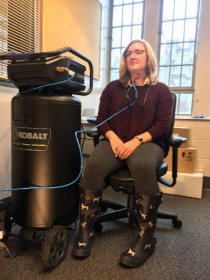
From high-tech air compressors and VR, to low-tech curtains, each project finds its niche solutions. “I’m interested in how people communicate emotions through touch,” adds Heather Kissel, another 3rd year PhD member of the lab, “so I needed a way for my pairs of participants to be able to touch each other without seeing each other.”
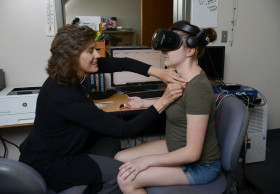
Kissel secured an award to help pay for equipment to allow anonymous touch between her participants. Her lab set-up now sports a sleek black curtain with Velcro opening just large enough for participants to slip their forearm through and await a touch with a designated emotion. Kissel is especially interested in whether having their physiology synchronized improves participants’ emotion recognition via touch.
Alex Faunce currently studies the effect of low frequency sound on cognition, emotion, and psychophysiology. “Low frequency sound is at the lower threshold of what humans can hear,” explains Faunce. “Exposure to this kind of sound is more bothersome than higher frequency sound of the same intensity level, and I want to get a better idea of why that happens.”
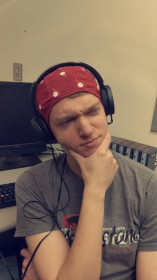
This introduces two related elements in the study of perception and psychology that Faunce would like to study. Psychoacoustics explores the impact of sound on the human sensory systems, a subject worthy of exploration itself. Also, low frequency sound may be particularly relevant for the safety and performance of people in industrial and automotive settings, where this sound predominates. Alex's hypothesis is that low frequency sound requires a higher cognitive load to filter out than higher-frequency noise, and this cognitive load may in turn be responsible for the fatiguing effects for the listener. In order to test their hypothesis, Faunce intends to use a combination of fancy new sound production equipment and electroencephalography.
To learn more about the Mind-Body Lab, you can visit them on Facebook, Twitter, or their website down below.
Twitter: @MBLVirginiaTech